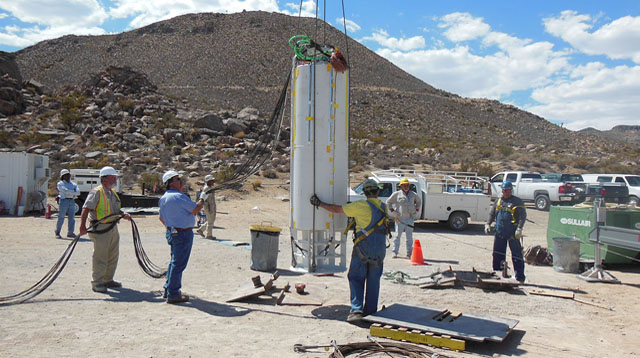6 April 2021–Comparison of coda waves, the scattered waves that arrive after the direct waves of a seismic event, can be used to determine the relative locations of two underground explosions, according to a new study published in the open-access journal The Seismic Record.
The technique, called coda wave interferometry, was tested on explosions conducted as part of the Source Physics Experiment (SPE). Lawrence Livermore National Laboratory researchers Sean Ford and Bill Walter report that coda wave interferometry can also put a limit on the extent of damage caused by an explosion.
The findings suggest the technique could be used to improve the estimates of the relative locations of larger explosions, such as the series of announced nuclear tests conducted by the Democratic People’s Republic of Korea over the past two decades.
“Based on the size and frequency scaling that we were able to employ in the paper and successes at SPE,” said Ford, “a conclusion point is that this technique could be used for larger explosions at larger separations recorded at more distant stations” such as those used to monitor North Korean testing.
Unlike the direct and strong P- and S-seismic waves produced by an earthquake or explosion event, coda waves arrive later and are more sensitive to scattering by the rock that they pass through. Any changes in the scattering structure—from rocks pushed or crushed by an explosion, for example–“will show up in how these later arriving waves have bounced around in that medium over a greater duration,” Ford explained.

In the new study, Ford and Walter used data from the SPE, an ongoing multi-institutional project involving Lawrence Livermore, Los Alamos and Sandia National Laboratories at the former Nevada nuclear test site. The SPE conducts chemical explosions to better understand the seismic waves they produce and to refine explosion detection techniques, using the analyses to improve monitoring of global nuclear explosions.
The researchers used coda wave interferometry to determine the known relative location of two chemical explosions that took place during Phase I of the SPE. The first explosion, SPE-1, was equivalent to 87.9 kilograms of TNT. The second explosion, SPE-2, was equivalent to 997 kilograms of TNT.
Their analysis concluded that the two explosions were located between 6 and 18 meters apart, and most likely 9.2 meters apart. The known separation between the two explosions is about 9.4 meters apart.
Previous research by seismologists David Robinson and coworkers showed that coda wave interferometry could precisely locate earthquakes separated by hundreds of meters. “We were confident that the approach would work for chemical explosions, but the question for us was whether it could work for such small and closely located explosions,” said Ford.
Ford and Walter also used the technique to better characterize the underground damage caused by SPE-2, comparing its coda waves with those produced by the 905-kilogram TNT equivalent SPE-3 that was later detonated in the same spot as SPE-2.
The details of the damage “can’t be seen from the direct waves arriving at the [1-kilometer or more] distant stations that we’re used to, so we thought perhaps we could see it in these more sensitive scattered waves, the coda waves,” Ford explained
Based on the analysis, the damage caused by SPE-2 must have been confined to a spherical region with a radius less than 10 meters, the researchers concluded.
“We thought there would be much more damage, or at least more of an effect on the outgoing waves, but now there is evidence against that hypothesis, so this points us in other directions to explain the observed P- and S-waves,” Ford said.
The study is the first research paper published in The Seismic Record, a new short-form, open-access journal from SSA.





修改评论